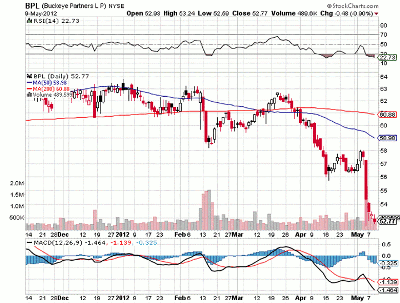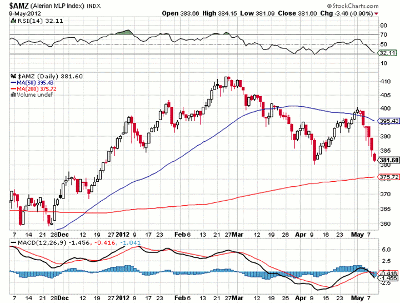Joseph Cioffi, contributor to Equities.com and blogger at MasterLimitedPartnerships.net, writes that sinking payouts from a key master limited partnership (MLP) has drawn the full attention of traders and investors.
Many traders who think they are trading a stock when they type in a symbol, may actually have actually traded a master limited partnership (MLP).
An MLP is a limited partnership that is publicly traded on a securities exchange. It combines the tax benefits of a limited partnership with the liquidity of publicly traded securities.
MLPs are limited by United States code to only apply to enterprises that engage in certain businesses, mostly pertaining to the extraction and transportation of natural resources such as petroleum and natural gas. Some real estate enterprises may also qualify as MLPs.
To qualify for MLP status, a partnership must generate at least 90% of its income from what the Internal Revenue Service (IRS) deems "qualifying" sources. For many MLPs, these include all manner of activities related to the production, processing, or transportation of oil, natural gas, and coal.
One MLP in particular has drawn the recent attention of traders and investors.
Buckeye Partners (BPL) has not been getting any kind of a break lately. This MLP took it on the chin last week when it announced earnings. The company’s earnings were disappointing across the board and there were a couple of flashing red lights to pay attention to.
Margins are shrinking and earnings missed estimates. Those are the obvious ones, but not the most important numbers. Scroll down to the bottom-line number, which for MLPs is distributable cash flow (DCF). In this metric, we have an issue.
DCF went from $87 million in the first quarter of 2011 to $73 million in the first quarter of 2012. The ratio needs to be above 1.00; meaning it needs to take in more than it’s paying out.
Distributable cash flow is the number-one metric in MLP land. It measures the return on investment to the partners in the MLP. Everything else is secondary. The payout ratio is at 0.78, down from 1.09 a year ago.
So, in English, the company took in $1.09 for every $1.00 it paid out. That’s a positive. Now, in the latest quarter, the company is paying out a buck but only taking in 78 cents. Sometimes, however, MLPs have seasonal factors that impact DCF where you have to look at the entire year.
Nustar (NS) is one MLP where this is the case. The company over the course of a year will average a DCF over 1.00 (at least so far it has).
But something at Buckeye is not right. The company said in its earnings that the environment is challenging. The company says it has positioned itself for improvement later in the year, but investors appear to be voting with both feet and the chart shows that the stock continues to move lower and trade closer to its 52-week lows.
We have also seen a slew of downgrades and some brokerage houses actually have a sell rating on BPL. You don’t see sell ratings too often. The yield is approaching 8%, which is two points above that of Kinder Morgan (KMP), which is near 6%. That two-point spread is a yellow light flashing and investors should exercise caution here. If the yield begins to move toward 9% or 10%, it will be the indicator that the distribution is in trouble. We are not there yet.
The Alerian MLP index tried to rally back to 400 and has gotten turned away. Watch that 380 level, which is the low made in early April. If that goes, then we have a serious correction in the group, which could take us down to the 360 level.
The next level below that is 320, which is the low from last September. A correction down to that level comes with either a massive spike in ten-year yields (which seems unlikely right now) or a severe correction in the overall market.
Here is a daily chart of that index:
By Joseph Cioffi, contributor to Equities.com and blogger at MasterLimitedPartnerships.net
Joseph Cioffi authors the blog Master Limited Partnerships, which covers the trading of stocks and breaking news, particularly companies in the oil and gas industry. The blog receives between 500 and 800 page views per trading day. Joe also daytrades stocks and markets, and since 2002 has turned over $50 million to $100 million dollars in trades per year.





















